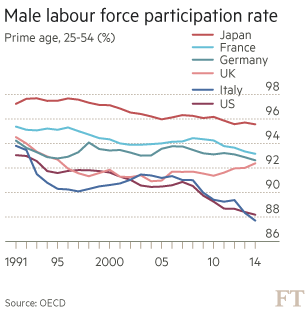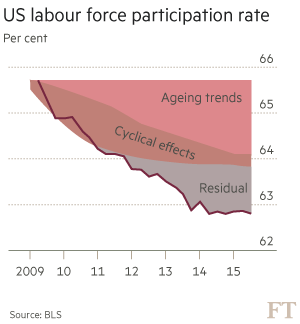In 2014, 12 per cent — close to one in eight — of US men between the ages of 25 and 54 were neither in work nor looking for it. This was very close to the Italian ratio and far higher than in other members of the group of seven leading high-income countries: in the UK, it was 8 per cent; in Germany and France 7 per cent; and in Japan a mere 4 per cent.
In the same year, the proportion of US prime-age women neither in work nor looking for it was 26 per cent, much the same as in Japan and less only than Italy’s. US labour market performance was strikingly poor for the men and women whose responsibilities should make earning a good income vital. So what is going on? (See charts.)
The debate in the US has focused on the post-crisis decline in participation rates for those over 16. These fell from 65.7 per cent at the start of 2009 to 62.8 per cent in July 2015. According to the Council of Economic Advisers, 1.6 percentage points of this decline was due to ageing and 0.3 percentage points due to (diminishing) cyclical effects. This leaves about a percentage point unexplained. Princeton’s Alan Krueger, former chairman of the council, argues that many of the long-term unemployed have given up looking for work. In this way, prolonged cyclical unemployment causes permanent shrinkage of the labour force.
Thus unemployment rates might fall for two opposite reasons: the welcome one would be that people find jobs; the unwelcome one would be that they abandon the search for them.
Happily, in the US, the former has outweighed the latter since the crisis. The overall unemployment rate (on an internationally comparable basis) has fallen by 5 percentage points since its 2009 peak of 10 per cent. In all, the proportion of the fall in the unemployment rate because of lower participation cannot be more than a quarter. Relative US unemployment performance has also been quite good: in September 2015 the rate was much the same as the UK’s, and a little above Germany’s and Japan’s, but far below the eurozone’s 10.8 per cent.
US cyclical unemployment performance has at least been decent by the standards of its peers, then. Yet as the 2015 Economic Report of the President notes, the UK experienced no decline in labour-force participation after the Great Recession, despite similar ageing trends to those in the US. Even on a cyclical basis, the decline in participation in the US is a concern. It is, however, the longer-term trends that must be most worrying. This is particularly true for the prime-aged adults.
Back in 1991, the proportion of US prime-age men who were neither in work nor looking for it was just 7 per cent. Thus the proportion of vanished would-be workers has risen by 5 percentage points since then. In the UK, the proportion of prime-aged men out of the labour force has risen only from 6 per cent to 8 per cent over this period. In France, it has gone from 5 to 7 per cent. So supposedly sclerotic French labour markets have done a better job of keeping prime-aged males in the labour force than flexible US ones. Moreover, male participation rates have been declining in the US since shortly after the second world war.
What has been happening to participation of prime-aged women is no less striking. In the US, female labour force participation rose strongly until 2000, when it was among the leaders. The US is the only G7 country to experience a sustained decline in the participation rate for prime-aged females since then. Japan, once far behind, has caught up.
What might explain the extent to which prime-aged men and women have been withdrawing from the labour market in the US over a long period? The comforts of idleness cannot be a plausible explanation since the US has the least generous welfare state among high-income countries. High minimum wages cannot be blocking job creation and so persuading low-skilled workers to abandon the search for jobs. According to the Organisation for Economic Co-operation and Development, US minimum wages were 20 per cent below UK levels in real terms in 2014 and far further below the generous levels in France. Moreover, the US still has the OECD’s least-regulated labour market.
So what might explain the trends? In the case of prime-aged women, the absence of affordable childcare would seem a plausible explanation. Society has apparently decided it does not want to pay to keep women in the workforce.
Another possible explanation is that labour market flexibility allows employers to substitute the young and the old for prime-aged workers. The US has relatively high participation rates for people aged 15 to 24. It has also experienced a big rise in the participation rate for people over 65, from 13 per cent in 2000 to 19 per cent in 2014. The latter puts it behind only Japan in the G7. Low minimum wages and high transport costs for workers living in sprawling US conurbations might also make low-wage work unprofitable. Particularly in the case of men, the numbers with criminal records created by mass incarceration might also help explain the difficulty in finding jobs and so their withdrawal from the labour force.
Finally, does the declining participation of prime-aged adults matter? Yes, it must: it matters if many believe they cannot earn enough in the labour market to support a family; and it matters if mothers lose their connection to the labour market. The relentless decline in the proportion of prime-aged US adults in the labour market indicates a significant dysfunction. It deserves attention and analysis. But it also merits action.
Martin Wolf
Fonte: FT


